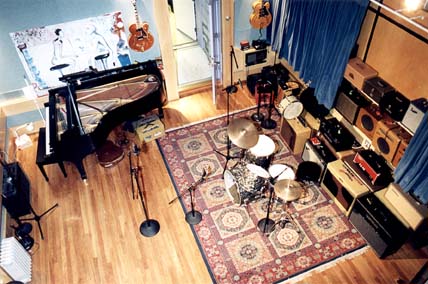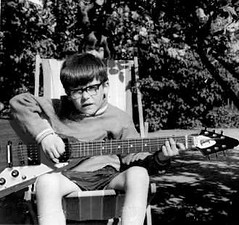Friday, August 22, 2008
LIVE IN THE STUDIO

That's a term that gets tossed about, but can mean a number of different things. Years ago, before multi-track mixing consoles became ubiquitous, all studio recording were 'live in the studio'.
Tonight at Smoke and Mirrors we recorded a new Himalaya song, and we did it live in the studio. Given all the advantages of modern audio recording technology, 'live in the studio' can be viewed as risky, and depending on the band, a complete waste of time.
When you record an entire band playing with all the amps and drums in one room you face a number of challenges. First, the band has to be up to it. Because everything is in the same room you get a lot of 'bleed'. Drums on the bass track, guitars on the drums track, every mic picks up a bit more than just the instrument you put it on. Due to the bleed, you can't go back later and overdub the mistakes; you're stuck with the performance. Thusly the band has to be able to deliver a solid track. An increasing rarity.
Secondly, you need to make sure that what's bleeding onto one track is in phase with that same bleed onto another track. The little bit of drums being picked up on Guitar 1 has to be in phase and the same volume as the little bit of drums bleeding onto Guitar 2. Tricky business.
I must give Chrispy credit for his foresight on the second account, and sorting it out during the line check. I would never have thought about it.
Himalaya did a great job, certainly considering the song is less than a week old. Take 7 was the keeper, and no one quit the band.

That's a term that gets tossed about, but can mean a number of different things. Years ago, before multi-track mixing consoles became ubiquitous, all studio recording were 'live in the studio'.
Tonight at Smoke and Mirrors we recorded a new Himalaya song, and we did it live in the studio. Given all the advantages of modern audio recording technology, 'live in the studio' can be viewed as risky, and depending on the band, a complete waste of time.
When you record an entire band playing with all the amps and drums in one room you face a number of challenges. First, the band has to be up to it. Because everything is in the same room you get a lot of 'bleed'. Drums on the bass track, guitars on the drums track, every mic picks up a bit more than just the instrument you put it on. Due to the bleed, you can't go back later and overdub the mistakes; you're stuck with the performance. Thusly the band has to be able to deliver a solid track. An increasing rarity.
Secondly, you need to make sure that what's bleeding onto one track is in phase with that same bleed onto another track. The little bit of drums being picked up on Guitar 1 has to be in phase and the same volume as the little bit of drums bleeding onto Guitar 2. Tricky business.
I must give Chrispy credit for his foresight on the second account, and sorting it out during the line check. I would never have thought about it.
Himalaya did a great job, certainly considering the song is less than a week old. Take 7 was the keeper, and no one quit the band.
Comments:
DAMN! You guys have done some serious work in the live room of S&M. When did you get a baby grand?
The most incredible Mudcrutch record was an all live, no overdubs, record.
Post a Comment
The most incredible Mudcrutch record was an all live, no overdubs, record.

